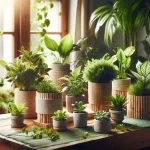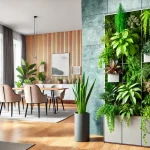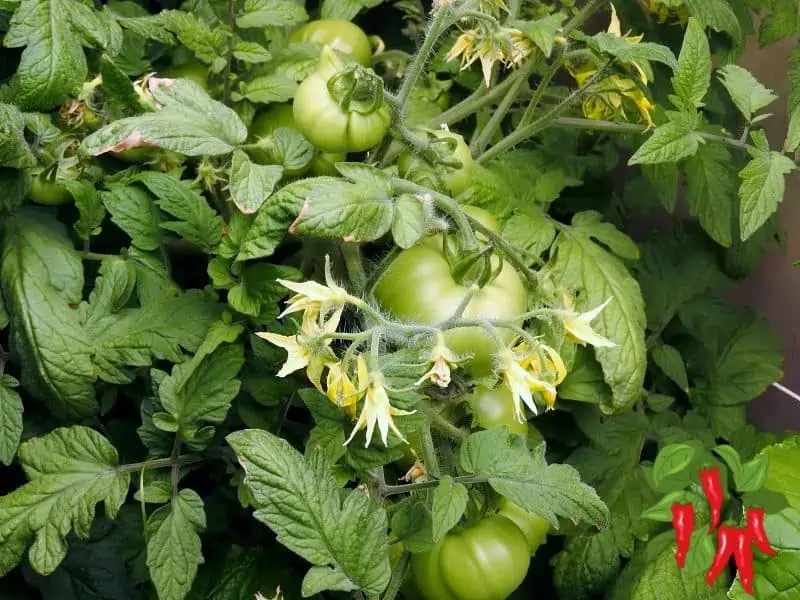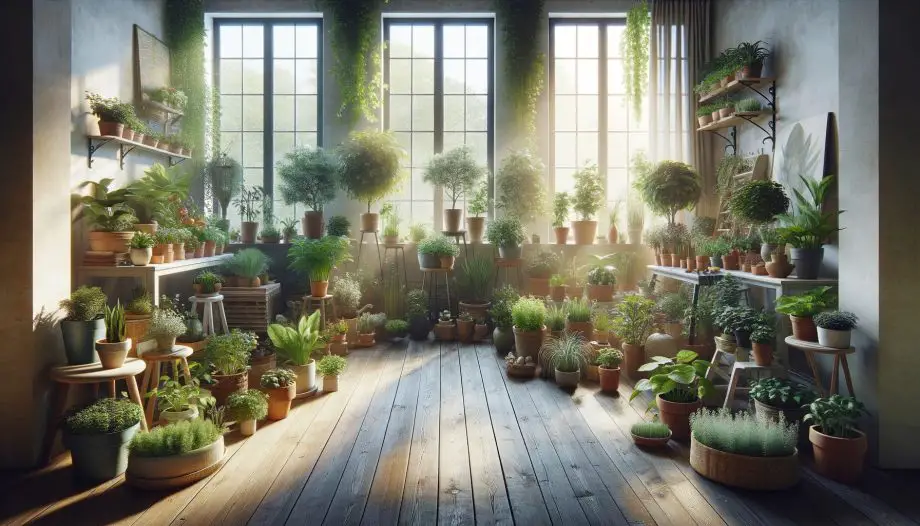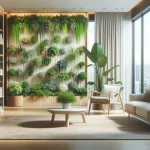This post may contain affiliate links. If you buy something from one of our links we may earn a commission. Thanks
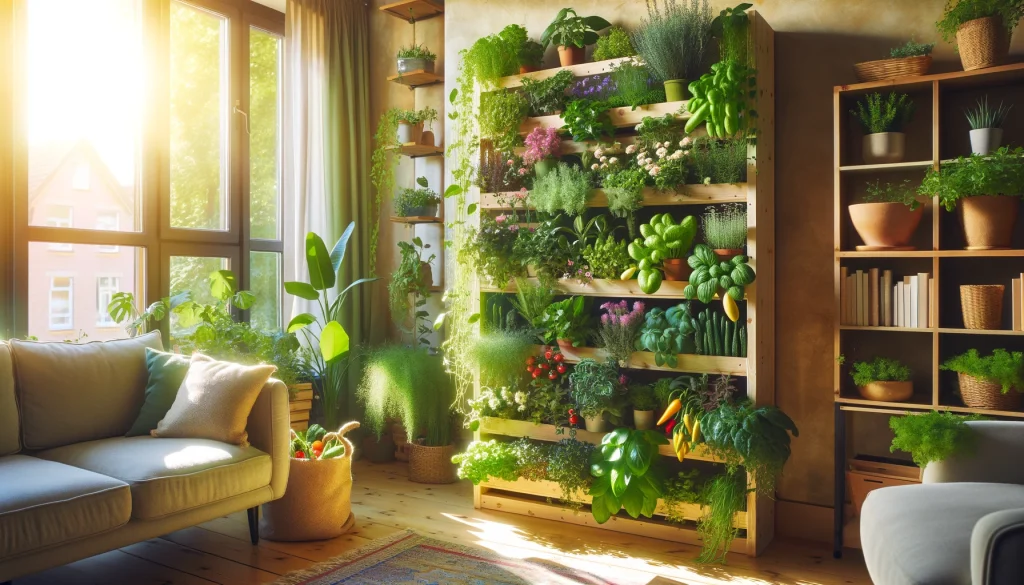
Have you ever wondered how to make the most of your small space while reaping the benefits of a lush garden? The benefits of vertical gardens go beyond just saving space.
They bring a breath of fresh air, literally and figuratively, to your indoor environment. Let’s explore how vertical gardening can transform your home!
Benefits of Vertical Gardens Key Takeaways
- Benefits of Vertical Gardens include improved air quality, space-saving design, noise reduction, and easier plant maintenance.
- They are perfect for small spaces and can transform any indoor area into a lush, green oasis.
Benefits of Indoor Vertical Gardening
Howdy everyone! Ever thought about turning your small space into a lush green haven?
Indoor vertical gardening might be the answer you’re looking for. It’s not just about saving space.
It’s also about enjoying fresh air and vibrant greenery right inside your home. Let’s dive into the many perks!
12 Benefits of Vertical Gardens
Ever wondered how to make your small space flourish? Vertical gardens are your ticket to a green paradise right at home.
From better air quality to space-saving magic, these gardens pack a punch. Let’s dig into the 12 amazing benefits that vertical gardening can bring to your life!
-
Better Air Circulation
- Vertical gardens improve airflow around plants, reducing the risk of fungus and disease, which often thrive in stagnant air.
-
Noise Reduction
- Plants in vertical gardens can absorb, refract, and reflect sound, reducing noise pollution indoors and making your space quieter and more serene.
-
Maintaining Vertical Gardens
- Vertical gardens are easier to maintain compared to traditional gardens. They require less bending and weeding, and plants are less likely to suffer from soilborne diseases and pests.
-
Define a Space
- Vertical gardens can act as natural room dividers, adding greenery to your interior design and creating distinct areas within your home or office.
-
Space Savers
- Ideal for small spaces, vertical gardens make efficient use of available room by growing plants upwards instead of outwards, maximizing the number of plants you can cultivate in limited areas.
-
Sustainability
- Vertical gardening can reduce your carbon footprint by providing natural insulation, lowering energy costs, and conserving water through efficient irrigation systems.
-
Aesthetics
- Vertical gardens enhance the visual appeal of your indoor spaces, creating lush, green environments that can boost your mood and overall well-being.
-
Grow More in Less Space
- By utilizing vertical space, you can grow a larger variety of plants, including vegetables and herbs, even in compact areas like balconies or small rooms.
-
Thermal Insulation
- Vertical gardens provide additional insulation for buildings, helping to maintain a consistent indoor temperature and reducing heating and cooling costs.
-
Healthier Plants
- Plants grown vertically are less susceptible to soilborne diseases and pests, leading to healthier and more robust growth.
-
Easier Management
- Vertical gardens simplify tasks like watering, pruning, and harvesting, making gardening less labor-intensive and more enjoyable.
-
Plant Variety
- Vertical gardening allows for a wide range of plants, from flowers and herbs to fruits and vegetables, enabling you to experiment with different species and enjoy a rich, varied garden.
Vertical Garden Advantages and Disadvantages
Alright, folks! Let’s chat about the ups and downs of vertical gardening. It’s a fantastic way to bring some green into your life, but like anything, it has its pros and cons. Let’s break it down.
Advantages
Space-saving: One of the biggest perks is how much space you can save. Vertical gardens make the most of limited space by growing upwards instead of outwards.
Indoor vertical gardening is perfect for apartments and small homes!
Improved Air Quality: Plants are natural air purifiers. A vertical garden can help remove toxins from the air, making your indoor environment healthier and fresher.
Aesthetic Enhancement: Vertical gardens are visually stunning. They add a touch of nature and beauty to your indoor or outdoor space, making it more inviting and serene.
Reduced Noise: Plants can absorb and block noise. Having a vertical garden can help reduce the sound from busy streets or noisy neighbors, creating a more peaceful atmosphere at home.
Easier Maintenance: Compared to traditional gardening, vertical gardens can be easier to maintain. They often require less weeding and can be set up with efficient watering systems, saving you time and effort.
Disadvantages
Initial Setup Cost: Getting started with a vertical garden can be pricey. You’ll need to invest in proper supports, containers, and possibly a good irrigation system.
Need for Proper Support Structures: Vertical gardens require sturdy structures to hold the weight of the plants and soil. This can sometimes be a bit tricky to set up and might need regular checks and maintenance.
Potential Challenges with Watering Systems: Ensuring all plants receive adequate water can be challenging. Some plants may get too much, while others might not get enough, especially in complex setups.
There you have it! While vertical gardens have some challenges, the benefits often outweigh the downsides, making them a great option for anyone looking to bring a bit of greenery into their lives.
Ready to explore more about vertical gardening? Just let me know!
Types of Vertical Gardening
All right, garden enthusiasts! Let’s dive into the different types of vertical gardening.
You can choose from a few main methods, each with its unique setup and benefits. Here’s a look at some popular types of vertical gardens.
Living Walls
Living walls, also known as green walls, are panels of plants grown vertically using hydroponics or soil.
These walls are great for indoor and outdoor spaces, adding a touch of greenery to any environment.
They can be as simple as a few panels or as elaborate as an entire wall covered in lush plants.
Living walls not only beautify your space but also help improve air quality and provide insulation.
Trellises and Arbors
Trellises and arbors are classic structures that support climbing plants like beans, peas, and flowering vines.
These structures can be made from wood, metal, or plastic and are perfect for both decorative and functional purposes.
Trellises are great for small gardens, patios, balconies, or even indoors where space is limited.
They allow plants to grow vertically, making harvesting easier and reducing the risk of pests and diseases.
Stacked Planters
Stacked planters are containers stacked vertically to maximize planting space. These planters are perfect for small balconies, patios, o indoor spaces.
They come in various shapes and sizes, allowing you to grow a variety of plants, from herbs and flowers to vegetables.
Stacked planters are easy to set up and maintain, making them a great option for beginner gardeners.
Pocket Gardens
Pocket gardens use fabric or plastic pockets attached to a wall or fence to grow plants.
These pockets are filled with soil and can hold a variety of plants. Pocket gardens are ideal for small spaces and can be used indoors or outdoors.
They are easy to install and maintain, and the pockets can be arranged in various patterns to create a unique garden design.
Hydroponic Towers
Hydroponic towers are vertical gardening systems that use a nutrient-rich water solution instead of soil.
These towers are perfect for growing herbs, leafy greens, and other small plants. Hydroponic towers are highly efficient, using less water than traditional gardening methods, and they allow for faster plant growth.
They are ideal for those looking to grow fresh produce year-round.
Vertical gardening offers a variety of options to fit any space and gardening style.
Whether you choose living walls, trellises, stacked planters, pocket gardens, or hydroponic towers, you’ll be able to enjoy the benefits of gardening in a compact, efficient, and beautiful way.
Vertical Gardening Systems
Now that we’ve covered the types of vertical gardens, let’s look at the different systems you can use.
Each system has its own setup and advantages, so you can find one that fits your needs perfectly. Here are some popular vertical gardening systems.
Hydroponic Systems
Hydroponic systems grow plants in nutrient-rich water solutions instead of soil. This method is highly efficient and allows plants to grow faster and healthier.
You can set up hydroponic systems in towers or vertical shelves, making the most of your vertical space.
- Efficient Water Use: Uses less water than traditional gardening.
- Faster Growth: Plants grow more quickly due to direct nutrient access.
- Indoor and Outdoor Use: Can be set up almost anywhere.
Vertical Hydroponic Systems – Hydroponic Towers on Amazon
Discover the convenience and efficiency of vertical hydroponic systems available on Amazon.
These innovative gardening solutions allow you to grow a variety of plants indoors without soil, making the most of your space while ensuring optimal growth conditions.
Read more about vertical gardening for small spaces
Perfect for both beginners and seasoned gardeners, these systems offer a modern approach to home gardening.
Hydroponics Growing System Vertical Garden Planter Indoor Smart Garden Kit
Hydroponics Growing System Vertical Garden Planter Indoor Smart Garden Kit
The Hydroponics Growing System Vertical Garden Planter is an innovative indoor smart garden kit designed to grow up to 30 plants.
Using a soilless cultivation method, this vertical garden utilizes a timed watering cycle, reducing water waste and ensuring efficient nutrient delivery to your plants.
The system includes a pump and a movable water tank, making it portable and easy to fit in various indoor spaces like kitchens and living rooms.
Benefits:
- Space-Saving Design: The vertical setup allows for growing a variety of plants in a compact area.
- Water Efficiency: The automatic watering system minimizes water usage compared to traditional gardening.
- Ease of Use: Suitable for all living environments, from apartments to villas, and requires minimal gardening knowledge.
- Healthy Growth: Provides optimal conditions for plants, leading to healthier and faster growth.
- Versatility: Grow a wide range of plants, including vegetables, fruits, flowers, and herbs, enhancing your indoor environment and lifestyle.
Gardyn 3.0 Hydroponics Growing System & Vertical Garden Planter
Gardyn 3.0 Hydroponics Growing System & Vertical Garden Planter
The Gardyn 3.0 is a next-generation vertical hydroponic growing system designed to maximize your indoor gardening experience.
It grows 30 large plants within just 2 square feet, using 95% less water than traditional methods.
This system features an easy plug-and-play assembly with no tools needed, a redesigned watering system, and enhanced durability.
Benefits:
- Space-Efficient: Grow 30 plants in only 2 square feet.
- Water-Saving: Uses 95% less water compared to traditional gardening.
- Easy Assembly: No screws or tools required for setup.
- Included Plants: Comes with 30 plant varieties in yCubes for easy germination.
- Optimized for Indoors: Requires only power and WiFi, with built-in lighting and precision watering.
- Sustainable Design: Made from high-quality, recyclable materials.
- AI Integration: Includes a 30-day trial of Gardyn’s AI Assistant, Kelby, for personalized plant care.
Modular Systems
Modular systems consist of pre-fabricated panels or pockets that can be easily mounted and maintained.
These systems are great for beginners and those looking for a low-maintenance option.
- Easy Installation: Simple to set up and customize.
- Built-in Irrigation: Often comes with integrated watering systems.
- Customizable Design: Panels can be arranged to fit any space.
Modular vertical gardening systems on Amazon:
Florafelt 12-Pocket Vertical Garden Planter
This system includes a panel with 12 pockets for planting. It’s made from durable materials and is designed to be easily mounted on a wall.
Compact Vertical Garden Kit – Living Wall System
This easy-to-mount wall gardening system features an
automatic timer that waters plants daily. Just add water to the reservoir weekly.
AgroSci Planter with Integrated Watering System
This vertical garden system has an integrated watering system, making it easy to maintain. It’s perfect for herbs, flowers, and small vegetables.
GreenStalk Vertical Garden Planter with Patented Internal Watering System
The GreenStalk system is a stackable planter with multiple tiers. It’s great for growing a variety of plants in a small space and includes a watering system that evenly distributes water to all tiers.
Mr. Stacky 5-Tiered Vertical Gardening Planter
This stackable planter is perfect for herbs, strawberries, and other small plants. It’s easy to set up and can be used indoors or outdoors.
These examples should give you a good idea of the variety of modular vertical gardening systems available on Amazon.
Each system has its own unique features, so you can find one that best fits your needs and space. Happy gardening!
DIY Systems
For those who love a good project, DIY systems are a fantastic option. You can create custom vertical gardens using recycled materials like old pallets, PVC pipes, or even shoe organizers.
- Creative Flexibility: Customize to fit your space and style.
- Eco-friendly: Reuse and repurpose materials you already have.
- Satisfaction of Creation: Enjoy the process of building your garden.
Wall-mounted Planters
Wall-mounted planters are another simple and effective system for vertical gardening.
These planters can be attached directly to walls or fences, allowing you to create a vertical garden anywhere.
- Space-saving: Perfect for small areas.
- Versatile: Suitable for herbs, flowers, and small vegetables.
- Aesthetic Appeal: Adds greenery to any wall.
Aeroponic Systems
Aeroponic systems are an advanced form of hydroponics where plants are grown in an air or mist environment without the use of soil or an aggregate medium.
- Precise Nutrient Control: Offers exact nutrient delivery.
- Fast Growth: Promotes quicker plant development.
- High Efficiency: Maximizes space and productivity.
Vertical gardening systems offer a variety of options to suit any gardener’s needs, from beginners to seasoned pros.
Whether you choose a hydroponic system, modular setup, DIY project, wall-mounted planters, or aeroponics, you’ll find that vertical gardening is a fun and rewarding way to grow plants in limited spaces.
How Do Vertical Gardens Work?
Let’s break down how vertical gardens work. These gardens utilize structures that support plant growth upwards, optimizing space and often using hydroponic systems for nutrient delivery.
Here’s how the magic happens.
Structural Support
Vertical gardens rely on a sturdy framework to hold plants and growing mediums. These structures can be made from a variety of materials such as metal, wood, or plastic.
The key is ensuring they are strong enough to support the weight of the plants and soil or other growing mediums.
- Frames and Panels: These provide the basic structure for the garden. They can be mounted on walls or freestanding.
- Trellises and Arbors: Used for climbing plants, these structures support vines and other plants as they grow upwards.
Hydroponic Systems
Hydroponic systems are often used in vertical gardens to provide plants with essential nutrients. Instead of soil, plants are grown in a nutrient-rich water solution, which delivers the necessary elements directly to the roots.
- Nutrient Delivery: A water solution mixed with essential nutrients is circulated to the plants’ roots.
- Efficient Use of Resources: Hydroponics uses less water than traditional soil-based gardening since the water is recirculated and reused.
- Growth Medium: Sometimes, a growth medium like coconut coir or perlite is used to support the roots and retain moisture.
Proper Lighting
Lighting is crucial for the success of vertical gardens, especially if they are indoors. Plants need adequate light to photosynthesize and grow healthily.
- Natural Light: Placing your vertical garden near a window can help, but often supplemental lighting is needed.
- LED Grow Lights: These are popular because they provide the full spectrum of light that plants need, and they are energy-efficient.
- Placement: Proper positioning of lights ensures that all parts of the plants receive enough light.
Irrigation Systems
Efficient irrigation is key to maintaining vertical gardens. The goal is to ensure all plants receive the right amount of water without overwatering or underwatering.
- Drip Irrigation: This system delivers water directly to the plant roots, minimizing waste and ensuring even distribution.
- Automated Systems: Timers and sensors can be used to automate watering schedules, making maintenance easier.
Plant Selection
Choosing the right plants is essential for a thriving vertical garden. Not all plants are suitable for vertical growth, so it’s important to select varieties that do well in these conditions.
Read more: Best Plants for Vertical Gardening: 10 Vertical Garden Tips – Stay Green Garden
- Climbing Plants: Vines like beans, peas, and flowering plants are ideal as they naturally grow upwards.
- Compact Varieties: Herbs, leafy greens, and small vegetables that don’t require a lot of horizontal space work well.
- Light Requirements: Ensure the plants you choose have similar light and water needs to simplify care.
Vertical gardens are a fantastic way to maximize your growing space, whether indoors or out.
By understanding the importance of structural support, hydroponic systems, proper lighting, irrigation, and plant selection, you can create a beautiful and productive vertical garden.
Plants for Vertical Gardens
Choosing the right plants is crucial for a successful vertical garden. Let’s look at some great options for herbs, vegetables, and flowers that thrive in vertical gardens.
Herbs
Herbs are perfect for vertical gardens because they are compact and easy to grow. They add flavor to your dishes and a delightful aroma to your space.
- Basil: Basil grows well in vertical gardens and is a fantastic addition to many dishes. It needs plenty of sunlight and regular watering.
- Mint: Mint spreads quickly, so it’s great for vertical planters where its growth can be controlled. It thrives in partial shade and moist soil.
- Parsley: Parsley is another great herb for vertical gardens. It grows well in full sun to partial shade and prefers well-drained soil.
Vegetables
Growing vegetables in a vertical garden can be incredibly rewarding. It allows you to maximize space and enjoy fresh produce.
- Tomatoes: Tomatoes are a favorite for vertical gardening. They need support as they grow, making them ideal for trellises or vertical planters. Ensure they get plenty of sunlight and regular watering.
- Cucumbers: Cucumbers are natural climbers and do well in vertical gardens. They require support structures like trellises and need lots of sun and consistent moisture.
- Lettuce: Lettuce is perfect for vertical gardens, especially in cooler climates. It grows quickly and can be harvested multiple times. It prefers partial shade and regular watering.
Flowers
Adding flowers to your vertical garden can brighten up your space and attract pollinators.
- Petunias: Petunias are vibrant and easy to grow. They thrive in full sun and need well-drained soil. They can cascade beautifully over vertical planters.
- Nasturtiums: Nasturtiums are great for vertical gardens. They are low-maintenance and can grow in poor soil conditions. Plus, their flowers are edible!
- Fuchsias: Fuchsias do well in vertical gardens, particularly in shaded areas. They have stunning flowers that add a pop of color to any garden.
Additional Tips
When selecting plants for your vertical garden, consider their growth habits and light requirements.
It’s best to choose plants with similar needs to simplify care. Also, think about the size of the plants at maturity to ensure they have enough space to grow.
With the right selection of herbs, vegetables, and flowers, your vertical garden can be both beautiful and productive. Happy gardening!
Benefits of Indoor Vertical Gardening FAQs
I know you might have some burning questions about vertical gardening, so I’ve put together this handy FAQ section.
Let’s dive into the most common questions and clear up any confusion.
Q: What is the benefit of vertical gardening?
A: Vertical gardening saves space, enhances air quality, and provides aesthetic and psychological benefits by bringing nature indoors. It’s perfect for small spaces and can turn any area into a lush, green haven.
Q: What is the science behind vertical gardening?
A: It involves growing plants on vertically inclined surfaces, often using hydroponics for nutrient delivery. This method improves airflow, optimizes light exposure, and ensures plants receive the necessary nutrients directly.
Q: What are the disadvantages of vertical gardening?
A: Potential high initial setup costs, need for specialized support structures, and challenges with irrigation and plant maintenance.
Q: Why would someone use a vertical garden?
A: To maximize space, improve indoor air quality, and enhance the visual appeal of their living or working environment.
Q: What is one of the advantages of growing plants vertically?
A: Growing plants vertically allows for more efficient use of space, enabling you to cultivate more plants in smaller areas, which is ideal for urban settings and small homes.
That wraps up our FAQ section! If you have more questions, feel free to ask.
Benefits of Vertical Indoor Gardening Conclusion
Well, garden lovers we’ve covered a lot of ground on vertical gardening, and I hope you’re as excited as I am about bringing some green into your life.
Vertical gardens are a fantastic way to maximize space, improve air quality, and add a touch of nature to any environment. Let’s wrap up with some final thoughts and key takeaways.
Benefits Recap
Vertical gardening offers numerous benefits that make it an attractive option for seasoned gardeners and beginners alike. Here’s a quick recap:
- Space-Saving: Perfect for small spaces, allowing you to grow more in less room.
- Improved Air Quality: Plants help purify the air, making your indoor environment healthier.
- Aesthetic Appeal: Vertical gardens add beauty and a touch of nature to any space.
- Noise Reduction: Plants can absorb and block noise, creating a quieter living area.
- Easier Maintenance: Vertical gardens can be easier to maintain than traditional gardens.
Types and Systems
We’ve explored different types of vertical gardens, from living walls and trellises to stacked planters and hydroponic towers. Each type has its unique advantages and can be tailored to fit your specific needs and space.
- Living Walls: Great for both aesthetics and improving air quality.
- Trellises and Arbors: Ideal for climbing plants and saving space.
- Stacked Planters: Perfect for growing a variety of plants in small areas.
- Hydroponic Systems: Efficient and ideal for year-round growing indoors.
Practical Tips
Implementing a vertical garden involves some planning and understanding of various systems:
- Structural Support: Ensure your garden has a sturdy framework.
- Proper Lighting: Use natural light or supplement with grow lights.
- Efficient Irrigation: Consider drip irrigation or automated systems for consistent watering.
- Plant Selection: Choose plants that thrive in vertical setups and have similar light and water needs.
Read more: Indoor Vertical Gardening: Start Your Indoor Garden Now
Key Takeaways
- Maximize Space: Vertical gardens are excellent for small areas, making efficient use of vertical space.
- Health Benefits: Improved air quality and reduced noise levels contribute to a healthier living environment.
- Aesthetic Value: Adds a beautiful and natural touch to any indoor or outdoor space.
- Ease of Maintenance: Vertical gardens can be easier to manage, especially with proper systems in place.
- Variety of Systems: Choose from hydroponic, modular, DIY, wall-mounted, or aeroponic systems to suit your needs.
Vertical gardening is a rewarding and practical way to bring nature into your home. Whether you’re looking to grow your own herbs, vegetables, or just add some greenery to your space, vertical gardens offer a versatile and effective solution. Happy gardening, and keep it green!
Ready for more gardening tips or have any questions? Just let me know!









